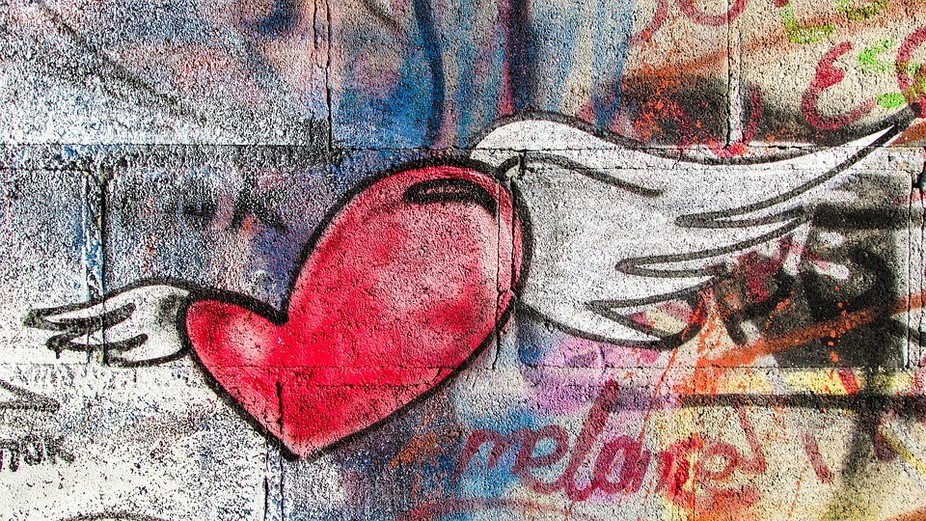Emotion embodies motion. When we experience emotions were are agitated and stirred, transported and animated. Motion is at the root of the word itself: emotion comes from the Latin, meaning to move out or away.
Many writers propose a small set of basic emotions, each with its own characteristic kind of inward and outward motion. Anger, disgust, fear, happiness, sadness and surprise have been studied exhaustively. However the elemental experience of being moved has been almost completely neglected.
A team of researchers has begun to unlock the secrets of this heart-melting state. As Valentine’s Day approaches, and many of us hope to move and be moved, let’s take a look.
Kama muta
The researchers refer to the experience of being moved by the Sanskrit expression kama muta, meaning “moved by love”. They define it as the sudden feeling of oneness with a person or other entity.
This emotion has a few characteristic features. People may feel chills, goosebumps and a sensation of heat in their chest, the source of the expression “heart-warming” and perhaps of the belief that the organ is emotion’s wellspring. They may get choked up, feel a lump in their throat, cry tears of joy and briefly stop breathing. After this intense feeling has passed, they may enjoy a sense of buoyancy and uplift.
Kama muta can occur in very diverse contexts. We may experience it with a loved one or in a sudden moment of empathy with a stranger. It can come over us when we read fiction, view art, listen to music or engage in religious observance.
Being moved gives us a sense of deep connection to something beyond our individual selves, but that thing may take many forms. We may be transported by a romantic partner, a baby, a favourite pet, a sporting team, a nation or a divine being.
Research on kama muta
Something as squishy as feeling moved might seem best left to poets and mystics. However researchers have made a valiant effort to study it scientifically. Two recently published papers highlight the work of their lab.
The first paper presented two studies that dissect the experience of being moved. The researchers first asked a sample of American adults to recall a recent occasion when their eyes became moist or teared up because of either a positive or a negative feeling. They then asked their participants to make a series of judgements about the episode.
The researchers found participants were more likely to say they felt “moved” or “touched”, and more likely to report a warm chest and goosebumps, when their tears were positive rather than negative. When recalling positive tears they were also more likely to report that people felt closer to each other at the end of the episode or that someone had done something morally exceptional.
In a followup study in the same paper, American and Norwegian adults rated videos selected to evoke being moved, happiness, sadness or anxiety. Their ratings of being moved by the videos were associated with witnessing increased closeness and moral action, and by the degree to which they experienced tears, a warm chest and chills. Being moved also appeared to be distinguishable from related emotions of awe and admiration.
The second paper investigates the dynamics of kama muta. It examines how the emotion unfolds over time, and the phenomena that accompany its fluctuations. To explore these changes, the researchers showed study participants a series of short but touching videos. These included depictions of an elephant rescue and another of performance artist Marina Abramovic.
As participants watched the videos they continuously recorded moment-to-moment changes in their feelings and perceptions. Throughout the videos they rated the degree to which they felt moved, the closeness of the people in the video, and whether they experienced crying, goosebumps, bodily warmth, happiness and sadness. The researchers then explored whether changes in these ratings mirrored changes in feeling moved.
The researchers found fluctuations in feeling moved were tightly tracked by changes in feelings of warmth, moist eyes, goosebumps, happiness and perceived closeness. They were unrelated to feelings of sadness. Kama muta appears to be subjectively positive, accompanied by the expected bodily symptoms and intimately tied to upswings in social connection.
Explaining kama muta
These two papers offer a descriptive analysis of kama muta, but how can we explain it? Both papers suggest social closeness plays a key role. Feelings of being moved were associated with increased closeness in people’s recollections, and they changed in lockstep with changes in the perceived closeness of video protagonists.
By implication, kama muta is fundamentally a relational emotion: one that reflects a particular kind of social connection. Specifically, the researchers argue, it occurs in response to the sudden intensification of a “communal sharing” relationship, one of four basic forms of relationship proposed by anthropologist Alan Fiske.
Relationships of this sort involve an understanding that the parties to the relationship form an undifferentiated unit. They feel fused or submerged in a common identity. Expert judgements of the intensity of this kind of bond in the videos in the second paper were strongly associated with the extent to which study participants felt moved.
If we understand being moved as an accompaniment to intensified communal relationships, it becomes clearer why the feeling arises in diverse contexts. Romantic and parental love are prototypical communal sharing relationships, but such relationships are not restricted to those between two flesh and blood individuals.
People may be communally related to nonhuman entities, fictional beings and human collectives. Abrupt intensification of communal connection to any of these things may therefore trigger kama muta. We may feel moved by a child’s tears or reunion with a lover, but also by our team’s victory, a patriotic song or a moment of deep connection to nature or a deity.
Being moved is a part of our emotional repertoire that is only now coming out of the shadows. Research on kama muta brings its throbbing, molten heart into the light.



 Pfizer Secures $10 Billion Deal for Obesity Drug Developer Metsera, Outbids Novo Nordisk
Pfizer Secures $10 Billion Deal for Obesity Drug Developer Metsera, Outbids Novo Nordisk  Trump Administration to Launch Autism Initiatives Targeting Acetaminophen Use and New Treatment Options
Trump Administration to Launch Autism Initiatives Targeting Acetaminophen Use and New Treatment Options  Eli Lilly’s Weight-Loss Pill Nears Fast-Track FDA Approval as Profits Surge on Global Demand
Eli Lilly’s Weight-Loss Pill Nears Fast-Track FDA Approval as Profits Surge on Global Demand  Obamacare Premiums Set to Double in 2026 as Subsidy Expiration Looms Amid U.S. Shutdown
Obamacare Premiums Set to Double in 2026 as Subsidy Expiration Looms Amid U.S. Shutdown  FDA Names Tracy Beth Høeg as Acting CDER Director After Richard Pazdur Announces Retirement
FDA Names Tracy Beth Høeg as Acting CDER Director After Richard Pazdur Announces Retirement  Eli Lilly’s Inluriyo Gains FDA Approval for Advanced Breast Cancer Treatment
Eli Lilly’s Inluriyo Gains FDA Approval for Advanced Breast Cancer Treatment  Canada Loses Measles-Free Status After Nearly 30 Years Amid Declining Vaccination Rates
Canada Loses Measles-Free Status After Nearly 30 Years Amid Declining Vaccination Rates  Novo Nordisk Appoints Greg Miley to Lead Corporate Affairs Amid U.S. Drug Pricing Pressure
Novo Nordisk Appoints Greg Miley to Lead Corporate Affairs Amid U.S. Drug Pricing Pressure  Novartis to Acquire Avidity Biosciences for $12 Billion to Strengthen Rare Muscle Disorder Portfolio
Novartis to Acquire Avidity Biosciences for $12 Billion to Strengthen Rare Muscle Disorder Portfolio  California Jury Awards $40 Million in Johnson & Johnson Talc Cancer Lawsuit
California Jury Awards $40 Million in Johnson & Johnson Talc Cancer Lawsuit  U.S. and Rwanda Sign $228 Million Health Partnership to Boost Self-Reliance
U.S. and Rwanda Sign $228 Million Health Partnership to Boost Self-Reliance  Trump and Merck KGaA Partner to Slash IVF Drug Costs and Expand Fertility Coverage
Trump and Merck KGaA Partner to Slash IVF Drug Costs and Expand Fertility Coverage  Pfizer Boosts Bid for Metsera Amid Intensifying Rivalry with Novo Nordisk in Obesity Drug Market
Pfizer Boosts Bid for Metsera Amid Intensifying Rivalry with Novo Nordisk in Obesity Drug Market  Trump Signs Executive Order to Boost AI Research in Childhood Cancer
Trump Signs Executive Order to Boost AI Research in Childhood Cancer 
































